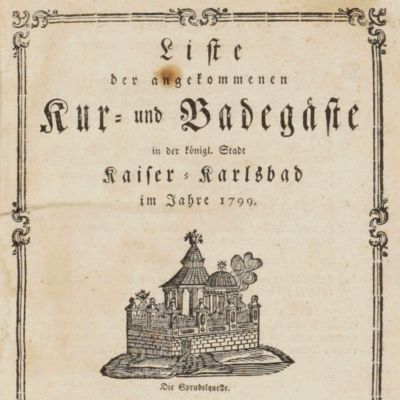[Wellness]
Liste der angekommenen Kur- und Badegäste in der königlichen Stadt Kaiser-Karlsbad im Jahre 1799.
Karlsbad, Franiek, [1800]. 4to (21.0 x 18.0 cm). 66 pp. Nice contemporary hand-stamped geometrical front cover [Papier dominoté].
With a list of 635 names in a nice woodcut frame, many of which are of German aristocracy such as Gräfin von Romanov, Prinzessin Sophia von Sachsen-Koburg, Reichsfreiherr Wiedersperger von Wiedersperg, Graf von Schwerin, as well as scientists such as Herrn von Trebra. "Karlovy Vary or Carlsbad (German: Karlsbad) is a spa town situated in western Bohemia, Czech Republic, on the confluence of the rivers Ohře and Teplá, approximately 130 km (81 mi) west of Prague (Praha). It is named after Charles IV, Holy Roman Emperor and King of Bohemia, who founded the city in 1370. It is historically famous for its hot springs (13 main springs, about 300 smaller springs, and the warm-water Teplá River). It is the most visited spa town in the Czech Republic ... Around 1350, Charles IV, Holy Roman Emperor organized an expedition into the forests surrounding modern-day Karlovy Vary during a stay in Loket. On the site of a spring, he established a spa called the Horké Lázně u Lokte (Hot Spas at Loket). The location was subsequently named Carlsbad in German after the emperor, who extolled the healing powers of the hot springs, at least according to legend. Charles IV granted the town privileges on 14 August 1370. Earlier settlements can also be found on the outskirts of today's town. ... Due to publications produced by physicians such as David Becher and Josef von Löschner, the town developed into a famous spa resort in the 19th century and was visited by many members of European aristocracy as well as celebrities from many fields of endeavour. It became even more popular after railway lines were completed from Prague to Cheb in 1870. The number of visitors rose from 134 families in the 1756 season to 26,000 guests annually at the end of the 19th century." (Wikipedia). The papier dominoté [Buntpapier, domino paper] front wrapper is unusual. Several mostly marginal annotations in pencil or ink, no rear wrapper, a few spots and stains, otherwise good. Rare.




